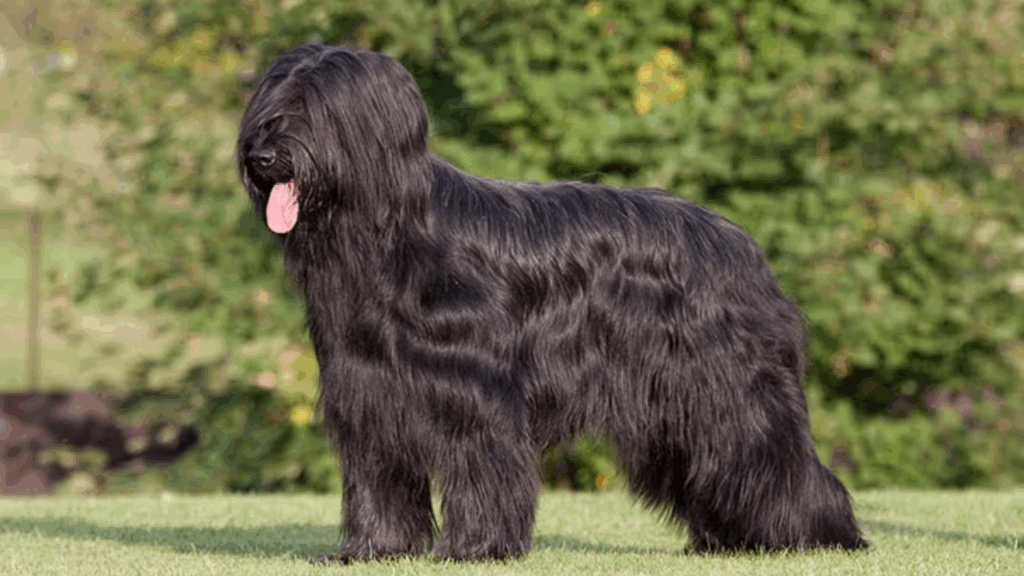The Briard is a powerful and loyal herding breed with origins in France, known for its shaggy coat, protective nature, and deep devotion to its family. For centuries, this breed has been a trusted companion to French shepherds, valued for both its working ability and courageous spirit. Often described as a “heart wrapped in fur,” the Briard is more than just a pretty face — it’s a dog with intelligence, instinct, and an unbreakable bond to those it loves.
Origins and History
The Briard has a long and storied history that dates back to at least the 8th century, with written references appearing in historical texts as early as the 14th century. This breed was developed in France as a herding and guarding dog, primarily used to protect sheep and livestock from predators and thieves.
The breed’s name is thought to be derived from the “Brie” region of France, though its exact origins are debated. Briards gained prominence during World War I when they were used as messenger dogs, search and rescue dogs, and to carry supplies to the front lines. Their bravery and intelligence made them invaluable to the French army.
Today, the Briard is known as both a skilled working dog and a loving household companion.
Physical Characteristics
The Briard is a large, muscular dog with a strong, square frame and a commanding presence. One of the breed’s most recognizable features is its long, flowing double coat, which gives it a rustic, majestic look.
Breed features:
- Height: 22 to 27 inches
- Weight: 55 to 100 pounds
- Build: Sturdy and athletic
- Coat: Long, coarse, slightly wavy outer coat with a fine undercoat
- Colors: Black, gray, or tawny
- Ears: Can be cropped or natural (cropped ears stand erect)
- Tail: Long and feathered with a distinctive hook at the end
The Briard also has unique “double dewclaws” on its hind legs — a trait required by the breed standard.
Temperament and Personality
The Briard is a blend of intelligence, independence, and devotion. Bred to think for itself while herding, it is a smart and confident dog that requires a firm but fair owner. It’s affectionate with its family but often reserved around strangers.
Key personality traits include:
- Loyal and protective: Forms strong bonds with family and is naturally watchful.
- Smart and trainable: Learns quickly, especially when training is engaging and positive.
- Energetic and playful: Enjoys physical activity and interactive games.
- Sensitive and intuitive: Responds to tone and mood, often described as emotionally intelligent.
- Good with children: Tends to be patient and gentle when raised with kids.
Though friendly and social, Briards can be aloof or territorial with unfamiliar people or animals. Early socialization is key to preventing overly protective behavior.
Living with a Briard
A Briard is not a couch potato. It is a working dog at heart and needs daily exercise and mental stimulation to stay happy and well-behaved. A bored Briard can become mischievous or anxious.
They do best in homes with:
- A yard to roam and play
- Owners who enjoy outdoor activities like hiking or walking
- Plenty of time for training and bonding
- A job or purpose, even if it’s something like agility or advanced obedience
Briards are extremely family-oriented and don’t do well in homes where they’re left alone for long stretches. They want to be involved in everything their family does.
Grooming and Care
The Briard’s stunning coat comes with some grooming responsibilities. While not prone to heavy shedding, their coat is long and can easily mat if not properly cared for.
Grooming needs include:
- Brushing: Several times a week to prevent tangles and mats
- Bathing: Every few weeks or as needed
- Ear and eye care: Regular cleaning to avoid infections
- Nail trimming and dental hygiene: As with all dogs
Grooming can be time-consuming, but it also offers a great opportunity to bond with your dog.
Health and Lifespan
Briards are generally healthy dogs with a life expectancy of 10 to 12 years. However, like all breeds, they can be prone to certain health conditions.
Common health concerns include:
- Hip dysplasia
- Progressive retinal atrophy (PRA)
- Bloat (gastric torsion)
- Hypothyroidism
Responsible breeders screen for these conditions to ensure healthier puppies. Regular vet checkups and a balanced diet will also help your Briard live a long, happy life.
Is the Briard Right for You?
If you’re looking for a smart, loyal, and hard-working dog with a majestic coat and a big heart, the Briard may be the perfect choice. However, they are best suited for experienced dog owners who can commit to their grooming and training needs.
If you’re ready to provide structure, love, and plenty of activity, the Briard will reward you with a lifetime of loyalty and affection.
In Summary
The Briard is a noble herding breed that combines elegance, strength, and a fiercely loyal heart. With the right environment and care, the Briard becomes more than just a pet — it becomes a devoted family guardian and a true friend.

Andy Parker is a dog lover, writer, and senior editor at BarkPicks. With years of experience covering canine health, training, and gear, he helps pet parents make smarter choices for happier, healthier dogs. Andy shares his home (and heart) with two rescue pups, Charlie and Mia.



